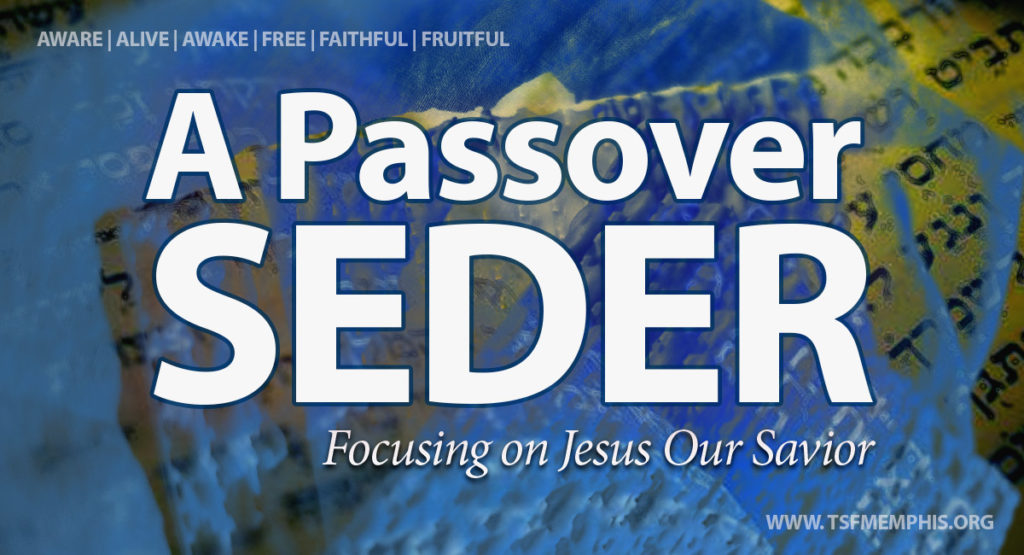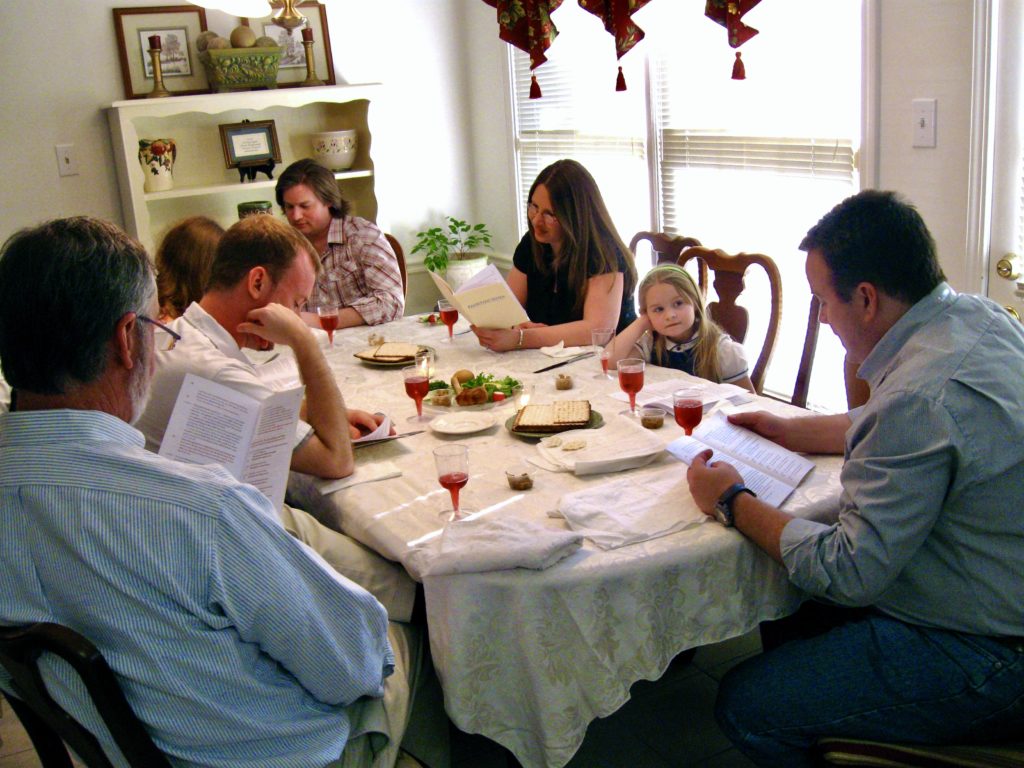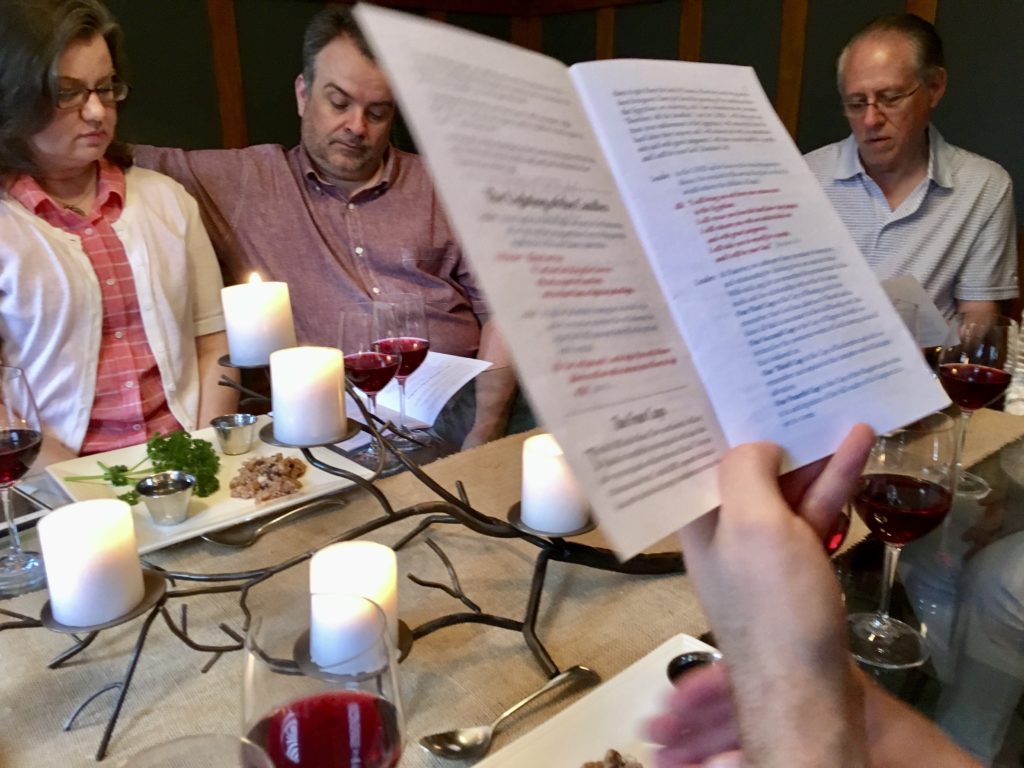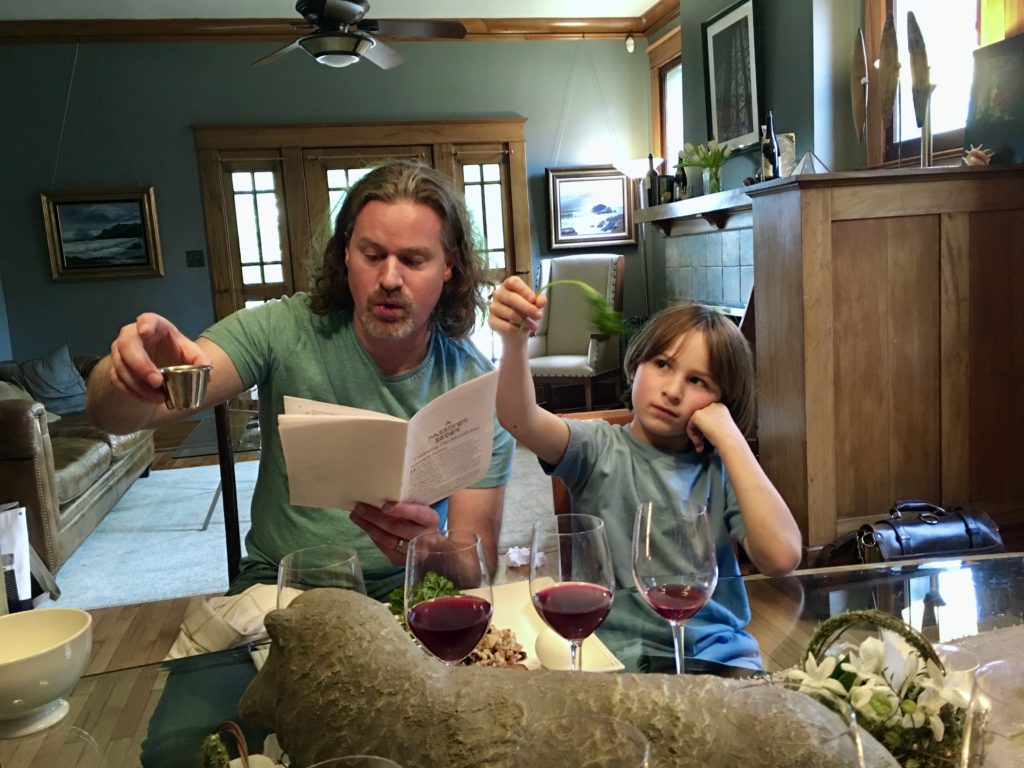Passover: A Family Seder

The order and readings for the Passover celebration are called a Haggadah and it means “the telling.” Passover is a story that has been retold for thousands of years. It is a story of miraculous redemption – from slavery to freedom, from despair to hope, from the darkness to the light. The power and grace of the Lord God is the focus of this story. The timelessness of this story comes from God’s intimate relationship with His people. As He cared for the children of Israel in ancient times, He also cares for all who are His today.


Thus begins our observance, each year, of the Passover Seder, a tradition that has become an important one in our family. We celebrate this Seder every Easter to remember that our God is a God of “miraculous redemption,” and that everything He orchestrates throughout Scripture points to the miraculous, redemptive work of Christ on the cross.
When our daughters were little, Stacy started working on a version of the Passover Seder to share in our church and small groups.

He did this because he realized that, while this “remembrance” is primarily a Jewish celebration, its relevance to the modern day believer is huge. Not only does the Passover Seder remember the saving works of our Father God in the Old Testament, but it points to what our Savior will do (and, indeed, DID do) in the New Testament. Jesus became our Passover lamb, using His own blood to rescue us from every form of Death. In celebrating the Passover, we see the fulfillment of Father God’s promises to Israel in the person and the sacrifice of His One Unique Son. The Seder that Stacy has pieced together was designed to have a more Christ-centered approach. It points from the events of Passover to our Lord’s saving work on the cross.
CLICK HERE For an excellent overview of The Feasts of Israel by Dr. Arnold Fruchtenbaum.

This Passover Seder has gone through many revisions and reiterations through the years. The end result is a celebration that is not only Christ-focused, but something that anyone can easily replicate. It is slightly more condensed than more traditional Jewish versions, but “chocked full” of meaning. And it has become an important focal point of our annual Easter celebration.
The following video is a fascinating discussion on the possible influence of Messianic Judaism on the development of the modern Seder.
We want to share this Seder with you. Its entitled “A Passover Seder: Celebrating Our Messiah Jesus.” We have included a LEADER/HOST Guide (on how to prepare for this event), as well as a PDF of the actual Seder service for participants.
Download Seder LEADER/HOST Guide here.
Download Seder PARTICIPANT Guide here.
This can be done with your extended family, in a small group setting, or with just the members of your own household. Whatever the circumstances, it is designed to give added weight and beauty to a holiday that, at its very center, brings us “from slavery to freedom, from despair to hope, from darkness to light.” We hope that it blesses you as it has blessed us.
A Brief History of Passover
The celebration of Passover has transformed over thousands of years, from its biblical origins to its observance in Jewish and Christian traditions. The following is a brief sketch of this history.
Origins in the Hebrew Scriptures
Passover (Pesach) originates in the narrative of The Exodus. Israel – the family of Abraham, Isaac and Jacob – had been living in and eventually enslaved in Egypt for about 430 years. The LORD heard the cries of His people and raised up Moses to lead them back to the Land promised to Israel. Because Pharoah was stubborn and did not want to release the people of Israel, The LORD sent a series of plagues to break his resolve. The final and most devastating plague was the killing of the firstborn males. The LORD instructed His people to mark their doorposts with the blood of a lamb so that the Destoyer would “pass over” the houses of the Israelites. The LORD instructed Israel to commemorate this event annually with a weeklong festival of unleavened bread (matzah) and the Passover sacrifice. The account of the Passover is found in Exodus 11:1-13:10.
In the following history of Israel, the celebration of the Passover was mostly neglected. However, both Hezekiah (2 Chronicles 30) and Josiah (2 Chronicles 35:1-17) re-instituted the Passover at times of great revival. After the period of 70 years of Babylonian Captivity, the Passover was celebrated again after the rebuilding of the Temple (Ezra 6:19).
Second Temple Period (515 BC – 70 AD)
The First Temple built during Solomon’s reign was destroyed by the Babylonians in 586BC. The Second Temple was rebuilt during the Intertestamental Period beginning around 500 BC. During this time, Passover became a pilgrimage festival. Thousands of Jews traveled to the Temple to offer the Passover lamb. By the time of Jesus, the meal included symbolic elements like wine, bitter herbs, and unleavened bread, which later influenced Christian traditions.
Passover in the New Testament
Luke 2:41-42 mentions that Jesus’ family went to Jerusalem every year for Passover, and at age 12, He stayed behind in the Temple, amazing the teachers with His understanding. John 2:13-53 describes Jesus going to Jerusalem for Passover and cleansing the Temple, driving out the money changers. John 6:4 mentions the approaching Passover before Jesus feeds the 5,000, linking the event to themes of provision and deliverance. Jesus’ last meal with His disciples was a Passover meal (see Matthew 26:17-30, Mark 14:12-26, Luke 22:7-20) During this meal, Jesus redefined and recontextualized the Bread to refer to His body and the wine to refer to His blood of the New Covenant. John 13–18 gives an extended account of Jesus’ final Passover, emphasizing His teachings and betrayal. John 19:14, 31-36 states that Jesus was crucified on the day of Passover preparation, at the same time the lambs were sacrificed in the Temple. In 1 Corinthians 5:7 Paul explicitly calls Jesus “our Passover Lamb, who has been sacrificed”, linking His death to the festival’s meaning. In Acts 12:1-4, in the early days of the Church, Luke mentions Herod arresting Peter during the Feast of Unleavened Bread, which follows Passover. Hebrews 11:28 refers to Moses keeping the first Passover as an act of faith, reinforcing its significance. In summary, the New Testament consistently presents Passover as both a Jewish festival observed by Jesus and His disciples and as a powerful symbol of Jesus’ sacrifice, fulfilling its deeper spiritual meaning. Passover is transformed from a commemoration of Israel’s liberation from Egypt to a symbol of Christ’s sacrifice and the redemption of humanity.
Post-Temple Rabbinic Judaism
After the destruction of the Temple in AD 70, the sacrificial aspect of Passover ended. At this time, focus on the Temple was replaced by the growing significance of The Rabbis and Rabbinical tradition. The Passover Seder, a ritual meal with storytelling, symbolic foods, and prayers from the Haggadah, developed during this time. Some modern Jewish scholars, like Robert Eisler andProf. Israel J. Yuval of Hebrew University, have made the case that the modern versions of the Seder are based on those shaped by Messianic Jews – Jewish Christians – in the Post-Temple period.
Some Suggested Resources:
A Passover Haggadah for Jewish Believers (English). Arnold Fruchtenbaum
What Every Christian Needs to Know About Passover: What It Means and Why It Matters. Rabbi Evan Moffic
Christ in the Passover. Ciel and Moshe Rosen
Christ in the Passover: Celebrate a Christian Seder. Pamphlet, Rose Publishing.




and will complete the work that you have begun in us.”
